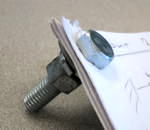a) Hand in in at the start of class on Wednesdays. Unless stated otherwise, homework is due on the first Wednesday that gives you 6 or more days to work on the HW. That is, homework associated with a Friday, Monday or Wednesday lecture is due 12, 9, or 7 days later, respectively. Late (1 minute or 2 months) homework will be accepted for reduced credit. More late, more reduction. Contact your grader to figure out how to turn in late homework.
b) On the first page of your homework, please put the following to ease sorting:
|
On the top left corner Please put a staple, e.g.: |
On the top right corner |
|
Very good, even excellent, and ....
more than needed (real example). |
Sally Golnaraghi MAE 4730 or 5730 HW 1, Due date |
c) As noted above, please, at home, put a Staple at
the top left corner. Folded interlocked torn corners fall apart. Paperclips
fall off.
d) Cite your help. At the top of each problem clearly
acknowledge all help you
got from TAs, faculty, students, or any other source (with exceptions
for lecture, text and section, which need not be cited). You could write,
for example: "Mary
Jones pointed out to me that I needed to draw the second FBD in problem
2." or "Nadia
Chow showed me how to do problem 3 from start to finish." or "I copied
this solution word for word from Jane Lewenstein "
or "I found a problem just like this one, number 386.5.6, at cheatonyourhomework.com,
and copied it." etc. You will not lose credit for getting and citing
such help. Don't violate academic integrity rules: be clear about which parts of your presentation you did not do on your
own. Violations of this policy are violations of the Cornell
Code of Academic Integrity.
e) Every use of linear or angular momentum balance
must be associated with a clear correct free body diagram.
f) Your vector notation must be clear and correct.
g) Every line of every calculation should be dimensionally
correct (carry
your units, read Appendix A of Ruina/Pratap book).
h) Your work should be laid out neatly enough to be
read by someone who does not know how to do the problem. Part of your
job as an engineer will be to convincingly get the right answers.
Your job on the homework is to practice this. Your goal should be "solutions
quality".
Each problem should start on a fresh page;
a new problem should not start on the same page as the ending of another
problem. A solution should be self-contained, including, for example, enough
of a problem restatment so that a reader need not see the original problem
statement. Box in your answers. Your solution should be clear and convincing
enough so that another student (who has not done the problem and does not
know how to do it) can read your solution, understand it, and judge that
it is correct. Your solution may be selected for posting (without your
name). If you do not want your solution posted, please say so on the top
of each homework.
i) Some problems may seem like make-work because
you already know how to do them. If so, you can get 90% credit by writing
in full "I can do this problem
but don't feel I will gain from writing out the solution" or, in
short,
"Can do, don't want to." You can keep doing this unless/untill
your grader/TA challenges your self-assessment.
j) Computer work should be well commented. Your name should be near the top of the computer text file. Before handing in, you should highlight (or circle with a colored pen) your name on the computer printout. At least some part of any other computer output should also include your name, printed by the computer. Highlight (or circle) your name on each page.
k) Grading and regrading. So long as you have made a good attempt at your first effort, you can get 90% credit by redoing a problem with 1 week of when it is returned to you.
l) Hold on to your homework. We may not record grades correctly as we go. At the end of the semester you we may ask you to hand in a folder of your completed HW.

